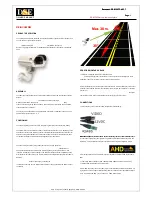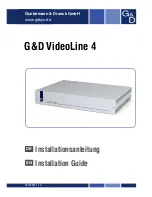
Cheetah KAC Camera User Manual | Camera Link (CLF) Interface
October 1, 2019
Page
86
of
135
Rev 7.2
5.1.2 Dual Video – Frame A / Frame B Switching
The cameras provide several options for switching between Frame A and Frame B (Dual
Video).
•
Manual
•
Automatic
•
Triggered
Manual switching:
Uses the computer software to switch between Frame A and Frame B.
Automatic switching
:
The camera outputs a user defined number of frame As (‘M’ frame As) followed by a user
defined number of Frame Bs (‘N’ Frame Bs) with this sequence repeated continuously. For
example, the camera can be programmed to output one Frame B for every sixty (60)
Frame A’s. The camera can be programmed to provide up to two hundred fifty-six (256)
Frame “A’s” followed by two hundred fifty-six (256) Frame “B’s”. The camera continues to
output ‘M’ Frame As followed by ‘N’ Frame Bs continuously.
Triggered Switching
:
There are two dual video triggered modes: Dual Video and Dual Video Triggered.
Frame A / Frame B:
With trigger enabled and in Frame A or Frame B mode, the
camera captures one frame of the selected Frame A or Frame B and outputs it on
each trigger.
Dual Video
: With the trigger enabled and Dual Video selected, the camera waits
for trigger. On receipt of trigger, the camera outputs a user selected number
(‘M’) Frame As followed by a user selected number (‘N’) Frame Bs then waits for
trigger.
Dual Video Triggered
: With trigger enabled and Dual Video Triggered mode
selected, the camera outputs Frame As continuously until a trigger is received.
Upon receipt of trigger, the camera outputs a user defined number (‘N’) of Frame
Bs then returns to outputting Frame As awaiting the next trigger pulse. Valid
Trigger sources as described in the Section 2.6: External Trigger
5.2 Global / Rolling Shutter
The C2880 and C4080 cameras support both rolling and global shutter operational modes.
In global shutter operational mode, all lines (and pixels) within the imaging array reset at
the same time and are then exposed. Readout follows exposure, then, lines read out of
the array sequentially. In this mode, every pixel in the array is exposed during the same
time period as determined by the cameras exposure control setting. This is useful if an
object within the scene is moving, since all pixels within the array capture the image at
the same instant in time. Global shutter introduces more noise into the image and
therefore is not as sensitive as rolling shutter operation.
In rolling shutter mode, the camera resets and exposes each line in the imaging array at a
slightly different time period. If there is motion within the scene, this can result in














































